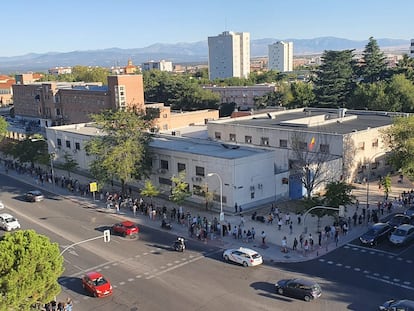Spain reports 9,000 new coronavirus cases, but spread of second wave is slowing
Neither epidemiological experts nor the Health Ministry are ruling out a strong uptick in cases in the coming days, as schools reopen and Spaniards return home from their summer vacations

The second coronavirus wave in Spain has lost momentum this week, according to the latest figures supplied by the central Health Ministry. On Thursday, a further 8,959 new cases were reported, without counting Murcia, which suffered technical problems reporting its figures. While the virus continues to spread, the number of weekly cases has actually fallen: Monday began with 47,264 cases detected over the last seven days, while the figure reported yesterday was 46,371.
It should be pointed out, however, that this is the weekly figure and does not mean that the epidemic has stopped growing nor can a change in be identified. Neither epidemiological experts nor the ministry itself are ruling out a strong uptick in cases in the coming days, as schools reopen and Spaniards return home from their summer vacations. In the midst of a wave, it is difficult to know where it is headed.
What’s more, the data can be deceptive, and the lag in time between the development of symptoms and the notification of such a case by the ministry is growing once more. This time frame can be as long as four days, when in June it was fewer than two. This is a result of the rise in cases seen in recent weeks, and increased pressure on healthcare centers, which is once again delaying the process between a person getting sick and their case appearing in the statistics. That said, in March and April, at the peak of the crisis in Spain, this process could take more than a week.
The pressure on Spain’s hospitals continues to grow slowly. The occupation of beds by Covid-19 patients is now somewhere between 6% and 7%
This delay of two to four weeks could explain why the cumulative incidence over the last 14 days has grown, according to last night’s figures: on Monday the data point was 205.5 per 100,000 inhabitants, while on Thursday the figure had grown to 212.9.
The distribution of cases is very uneven according to region. Madrid continues to account for a third of total positives in Spain, and incidence has reached as high as 467 cases per 100,000 inhabitants in the last two weeks. It is followed by the Basque Country (363.9) and La Rioja (362.2). The rest of Spain’s territories come in below 300, with Asturias the lowest at 51. This is well above neighboring countries, such as Portugal (35.4), the United Kingdom (24.6), Germany (19.4) and Italy (25.5). France exceeds the figure in Asturias, however, with 93.4, but this is still around half of the overall Spanish average.
The pressure on Spain’s hospitals continues to grow slowly. The occupation of beds by Covid-19 patients is still at 6%, but Fernando Simón, the director of the Health Ministry’s Coordination Center for Health Alerts (CCAES), recognized at a press conference on Thursday evening that it is now very close to 7% (the ministry report does not offer decimal places for the figure). Madrid also has the highest pressure on its hospitals, with 16% of beds occupied by Covid-19 patients, nearly double the figure for August 20, when the ministry began supplying the figure for the first time. It is followed by Aragón (12%), the Balearic Islands and the Basque Country (both 11%).
Simón was very cautious on Thursday when it came to anticipating improvements in the figures. “With the data that we have we can say that the disease appears to be advancing slower than it was,” he explained. “Where there were big rises [in infections], they are falling. They could fall in the coming days, but we have to be wary of what we are observing and what we are detecting.”
The distribution of cases is very uneven according to region. Madrid continues to account for a third of total positives in Spain
In the coming days, the CCAES director is predicting a rise in infections in areas with few cases to which people are returning from zones with more infections, but he said he thought that in the provinces where transmission rates are already high, the return to work and school will not have a noticeable effect. One of the jobs of the health authorities in the coming weeks will be to detect whether having students back in the classroom causes infections to go up.
“If transmission rises among students, but it does so at the same rhythm as in the community, that will mean that schools are not focal points of infection,” he explained. “If it does so faster, that will mean that schools could be focal points, and this will have to be evaluated from center to center,” he continued, expressing his support for the reopening of schools.
Simón said he was satisfied with the data from current outbreaks, which are gradually getting smaller. This, in his opinion, means that recent restrictions – such as the closure of nightclubs and bars – are having an effect. According to the data from the Health Ministry, since the deescalation of confinement measures came to an end in June, a total of 3,061 outbreaks have been reported with 29,500 cases. Nearly 80% are small, with fewer than 10 people affected. “The outbreaks with higher numbers of cases, some with more than 100, are taking place in leisure areas, among workers who are in vulnerable situations and in social and health centers,” the ministry report states.
English version by Simon Hunter.
Tu suscripción se está usando en otro dispositivo
¿Quieres añadir otro usuario a tu suscripción?
Si continúas leyendo en este dispositivo, no se podrá leer en el otro.
FlechaTu suscripción se está usando en otro dispositivo y solo puedes acceder a EL PAÍS desde un dispositivo a la vez.
Si quieres compartir tu cuenta, cambia tu suscripción a la modalidad Premium, así podrás añadir otro usuario. Cada uno accederá con su propia cuenta de email, lo que os permitirá personalizar vuestra experiencia en EL PAÍS.
¿Tienes una suscripción de empresa? Accede aquí para contratar más cuentas.
En el caso de no saber quién está usando tu cuenta, te recomendamos cambiar tu contraseña aquí.
Si decides continuar compartiendo tu cuenta, este mensaje se mostrará en tu dispositivo y en el de la otra persona que está usando tu cuenta de forma indefinida, afectando a tu experiencia de lectura. Puedes consultar aquí los términos y condiciones de la suscripción digital.
More information
Últimas noticias
Most viewed
- Reinhard Genzel, Nobel laureate in physics: ‘One-minute videos will never give you the truth’
- Oona Chaplin: ‘I told James Cameron that I was living in a treehouse and starting a permaculture project with a friend’
- Pablo Escobar’s hippos: A serious environmental problem, 40 years on
- Charles Dubouloz, mountaineering star, retires at 36 with a farewell tour inspired by Walter Bonatti
- Why we lost the habit of sleeping in two segments and how that changed our sense of time










































